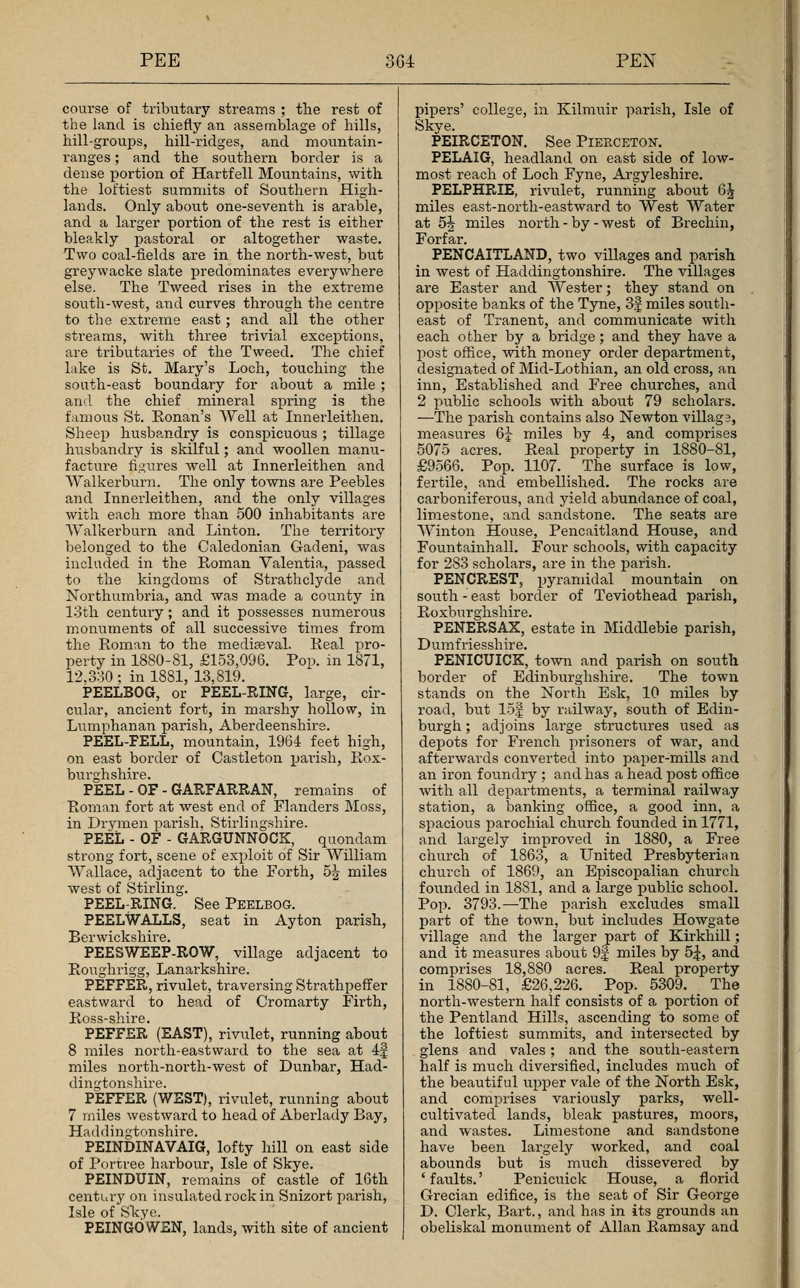PEELBOG, large, circular, ancient fort, in marshy hollow, in Lumphanan parish, Aberdeenshire.
PEEL-FELL, mountain, 1964 feet high, on east border of Castleton parish, Roxburghshire.
PEEL - OF - GARFARRAN, remains of Roman fort at west end of Flanders Moss, in Drymen parish, Stirlingshire.
PEEL - OF - GARGUNNOCK, quondam strong fort, scene of exploit of Sir William Wallace, adjacent to the Forth, 5J miles west of Stirling.
PEEL-RING.
PEELWALLS, seat in Ayton parish, Berwickshire.
PEESWEEP-ROW, village adjacent to Roughrigg, Lanarkshire.
PEFFER, rivulet, traversing Strathpeffer eastward to head of Cromarty Firth, Ross-shire.
PEFFER (EAST), rivulet, running about 8 miles north-eastward to the sea at 4f miles north-north-west of Dunbar, Haddingtonshire.
PEFFER (WEST), rivulet, running about 7 miles westward to head of Aberlady Bay, Haddingtonshire.
PEINDINAVAIG, lofty hill on east side of Portree harbour, Isle of Skye.
PEINDUIN, remains of castle of 16th century on insulated rock in Snizort parish, Isle of S"kye.
PEINGOWEN, lands, with site of ancient pipers' college, in Kilmuir parish, Isle of Skye.
PEIRCETON.
PELAIG, headland on east side of low-most reach of Loch Fyne, Argyleshire.
PELPHRIE, rivulet, running about 6 miles east-north-eastward to West Water at 5^, miles north-by-west of Brechin, Forfar.
PENCAITLAND, two villages and parish in west of Haddingtonshire. The villages are Easter and Wester; they stand on opposite banks of the Tyne, 3| miles south-east of Tranent, and communicate with each other by a bridge ; and they have a post office, with money order department, designated of Mid-Lothian, an old cross, an inn, Established and Free churches, and 2 public schools with about 79 scholars. The parish contains also Newton villaga, measures 6J miles by 4, and comprises 5075 acres. Real property in 1880-81, 9566. Pop. 1107. The surface is low, fertile, and embellished. The rocks are carboniferous, and yield abundance of coal, limestone, and sandstone. The seats are Winton House, Pencaitland House, and Fountainhall. Four schools, with capacity for 283 scholars, are in the parish.
PENCREST, pyramidal mountain on south-east border of Teviothead parish, Roxburghshire.
PENERSAX, estate in Middlebie parish, Dumfriesshire.
PENICUICK, town and parish on south border of Edinburghshire. The town stands on the North Esk, 10 miles by road, but lof by railway, south of Edinburgh ; adjoins large structures used as depots for French prisoners of war, and afterwards converted into paper-mills and an iron foundry ; and has a head post office with all departments, a terminal railway station, a banking office, a good inn, a spacious parochial church founded in 1771, and largely improved in 1880, a Free church of 1863, a United Presbyterian church of 1869, an Episcopalian church founded in 1881, and a large public school. Pop. 3793. The parish excludes small part of the town, but includes Howgate village and the larger part of Kirkhill ; and it measures about 9| miles by 5, and comprises 18,880 acres. Real property in 1880-81, 26,226. Pop. 5309. The north-western half consists of a portion of the Pentland Hills, ascending to some of the loftiest summits, and intersected by glens and vales ; and the south-eastern half is much diversified, includes much of the beautiful upper vale of the North Esk, and comprises variously parks, well-cultivated lands, bleak pastures, moors, and wastes. Limestone and sandstone have been largely worked, and coal abounds but is much dissevered by ' faults. ' Penicuick House, a florid Grecian edifice, is the seat of Sir George D. Clerk, Bart., and has in its grounds an obeliskal monument of Allan Ramsay and a lofty circular observatory tower. Newhall House includes part of an ancient strong castle, and adjoins the scenery of Ramsay's Gentle Shepherd, Bevelaw House, Ravensnook Castle, Brunstane Castle, and Logan House are interesting antiquities. A United Presbyterian church is at Howgate. Eight schools for 990 scholars are in the parish, and 1 of them and an enlargement for 154 are new.

